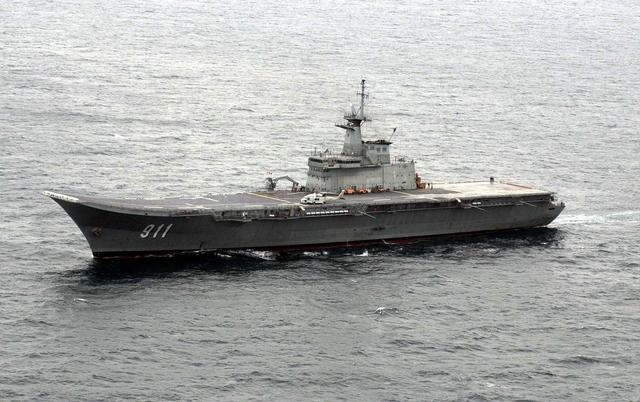Chakri Narubet-class
Description
HTMS Chakri Naruebet is the flagship of the Royal Thai Navy (RTN) and Thailand's first and only aircraft carrier, albeit referred to by the RTN as an "Offshore Patrol Helicopter Carrier." It was ordered from the Spanish shipbuilder Bazán in 1992 and commissioned into the RTN in 1997. As the smallest functioning aircraft carrier in the world, it is based on the design of the Spanish Navy's Príncipe de Asturias and was constructed as a part of the United States Navy's Sea Control Ship concept.
Designed to operate an air group of V/STOL fighter aircraft and helicopters, Chakri Naruebet was initially fitted with an aircraft ski-jump and was intended to operate ex-Spanish AV-8S Matador Harrier V/STOL aircraft and Sikorsky SH-60 Seahawk helicopters. However, due to parts, training, and fiscal limitations, by 1999 only one Matador was operational, and all Harrier V/STOL jets were removed from service by 2006. Though designed for patrols and force projection, a lack of funding due to the 1997 Asian Financial Crisis has resulted in the carrier spending much of its career docked at the Sattahip naval base.
The vessel is propelled by a combined diesel or gas system, can reach a maximum speed of 25.5 knots, and has a range of up to 10,000 nautical miles. Its armament includes two .50 caliber machine guns and three Matra Sadral sextuple surface-to-air missile launchers with Mistral missiles. It is also fitted for but lacks certain installations, such as the Mark 41 Vertical launch system for Sea Sparrow missiles. While designed to operate up to six AV-8S Matador aircraft and a number of helicopters, its air wing has been notably inconsistent due to operational issues.
Chakri Naruebet's operational history includes several disaster relief operations, with notable service following the 2004 Indian Ocean earthquake and tsunami. Subject to criticism as acting more as an oversized royal yacht due to limited use for naval purposes, it leaves port mostly for a single training day per month. Nevertheless, its recent operational tempo has supposedly increased, participating in more frequent naval exercises and joint operations.
For its sensor suite, Chakri Naruebet has a Hughes SPS-52C air search radar and two Kelvin-Hughes 1007 navigational radars. Upgrades include the contracting of Saab to revamp its command and control system, providing a new radar and improved data links. In an exercise conducted by the Royal Thai Navy in 2021, networked data links were established between the carrier, Gripen fighters, and other ships demonstrating improved operational capabilities.
Construction of Chakri Naruebet began in October 1993, with the hull laid down in 1994, launched in 1996, and handed over in 1997. It underwent sea trials, including aviation trials in coordination with the Spanish Navy, before it formally entered service in August of that year. The carrier cost roughly $336 million to build and is assigned to the Third Naval Area Command with intended duties spanning from amphibious support to SAR operations. Despite this, due to its reduced operational state, it has been involved in significantly fewer activities than anticipated for a vessel of its type. The carrier remains a unique element of the Thai Navy, sometimes making appearances in international maritime reviews and serving as a tourist attraction at its home port.
Summary
| Origin country | 🇹🇭 Thailand |
| Category | Aircraft carrier |
| Subtype | V/STOL aircraft carrier |
| Manufacturer | Bazan |
| Year commissioned | 1997 |
| Approx. unit cost | $285 million |
| Units | 911 CHAKRI NARUBET |
| Current operators | 🇹🇭 Thailand |
Technical specifications
| Displacement | 11500 tons |
| Range | 18000 km at 12 knots |
| Crew | 601 members |
| Width | 22.5 m (73.8 ft) |
| Length | 182.65 m (599.2 ft) |
| Air Park | 6 Matador UAVs, 6 SH-60 helicopters |
| Propulsion | 2 General Electric LM 2500 gas turbines with a power of 44,250 hp - 2 propellers |
| Thrust | 12000 hp |
| Armament | 3 Sadral (VIII 3) |
| Maximum speed | 26 knots |
